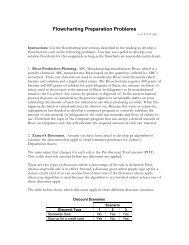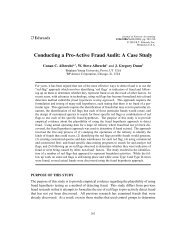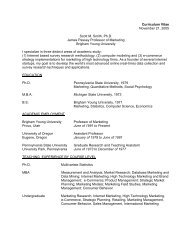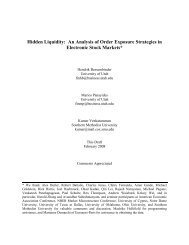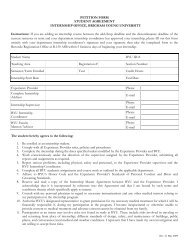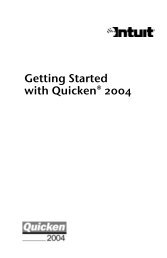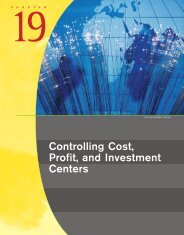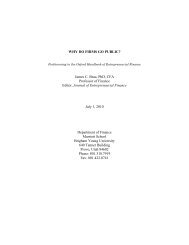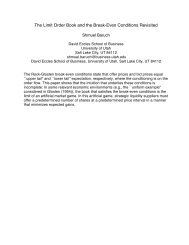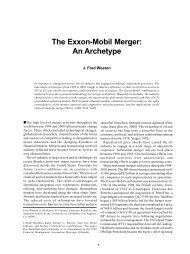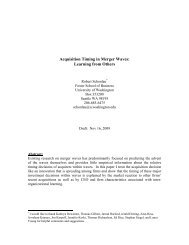Economies of Scale and Minimum Efficient Scale - Marriott School
Economies of Scale and Minimum Efficient Scale - Marriott School
Economies of Scale and Minimum Efficient Scale - Marriott School
You also want an ePaper? Increase the reach of your titles
YUMPU automatically turns print PDFs into web optimized ePapers that Google loves.
4. Massed reserves — lower costs for back up specialized machines (e.g. you need a back-up<br />
if you have one or five machines running). Fewer maintenance personnel are required per<br />
machine/plant; also useful when unit/machine shutdowns occur regularly <strong>and</strong> predictably.<br />
1.3 <strong>Economies</strong> <strong>of</strong> Multi-Plant Operations —<br />
associated with total corporate size<br />
1. <strong>Economies</strong> <strong>of</strong> scale in centralized service functions, such as R&D <strong>and</strong> management/staff.<br />
Costs per unit are lower by having a common central pool <strong>of</strong> researchers, financial planners,<br />
accountants, purchasing agents, lawyers, etc.<br />
2. Value <strong>of</strong> experimentation <strong>and</strong> diversity <strong>of</strong> operations wherein knowledge from one plant can<br />
be transferred to other plants. Shared production experience (best demonstrated practices)<br />
across plants can increase efficiencies.<br />
3. <strong>Economies</strong> <strong>of</strong> scale in raising capital through common stock issues <strong>and</strong> borrowing. For example,<br />
firms with $200 mm in assets borrow on average at 0.74 percentage points less than<br />
$5 mm asset firms; $1 billion asset firms borrow for 1.08 percentage points less. (1960’s;<br />
Scherer et al.) This is due to reduced variance in pr<strong>of</strong>its (lower perceived risk). The CAPM<br />
pricing model is typically used to assess risk <strong>and</strong> even one bad year <strong>of</strong> earnings is perceived<br />
as a trend. Thus, larger companies in more concentrated industries have lower Betas. Also, a<br />
firm <strong>of</strong> $500 mm assets can borrow $25 mm at close to the prime rate but if it tries to borrow<br />
$100 - 500 mm in a short time frame, it will have to pay a steep interest premium. Such capital<br />
market imperfections may contribute to concentration in capital intensive industries like<br />
steel, autos, petrol. refining, etc., requiring a very high capital investment for minimum efficient<br />
scale (MES) operation. Small competitors may have considerable difficulty financing<br />
a great leap forward in MES operation.<br />
4. <strong>Economies</strong> <strong>of</strong> scale in advertising which allow you to achieve a ”minimum threshold” <strong>of</strong><br />
advertising messages to influence the consumer; however, above the minimum threshold at<br />
some point there appears to be diminishing returns to advertising. (e.g., according to reports,<br />
some beer drinkers deluged with Budweiser ads, said, “Give me anything but a Bud.”)<br />
5. The ability to locate plants to reduce distribution/transportation costs associated with getting<br />
the product to the end user (e.g. especially with low value to bulk items or items with special<br />
distribution properties like ice, dairy products, cement, etc.)<br />
2 Diseconomies <strong>of</strong> <strong>Scale</strong><br />
For many firms, there are also observed ranges <strong>of</strong> output that exhibit diseconomies <strong>of</strong> scale. Over<br />
these ranges, average cost is rising as output increases. Diseconomies <strong>of</strong> scale put limits on scale<br />
<strong>and</strong> complicate efforts to realize the cost advantages <strong>of</strong> economies <strong>of</strong> scale. Reasons for diseconomies<br />
<strong>of</strong> scale include<br />
2



